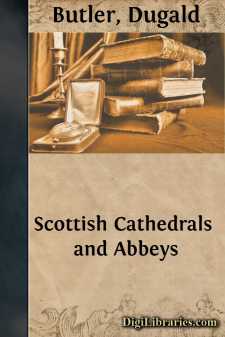Categories
- Antiques & Collectibles 13
- Architecture 36
- Art 48
- Bibles 22
- Biography & Autobiography 813
- Body, Mind & Spirit 142
- Business & Economics 28
- Children's Books 15
- Children's Fiction 12
- Computers 4
- Cooking 94
- Crafts & Hobbies 4
- Drama 346
- Education 46
- Family & Relationships 57
- Fiction 11829
- Games 19
- Gardening 17
- Health & Fitness 34
- History 1377
- House & Home 1
- Humor 147
- Juvenile Fiction 1873
- Juvenile Nonfiction 202
- Language Arts & Disciplines 88
- Law 16
- Literary Collections 686
- Literary Criticism 179
- Mathematics 13
- Medical 41
- Music 40
- Nature 179
- Non-Classifiable 1768
- Performing Arts 7
- Periodicals 1453
- Philosophy 64
- Photography 2
- Poetry 896
- Political Science 203
- Psychology 42
- Reference 154
- Religion 513
- Science 126
- Self-Help 84
- Social Science 81
- Sports & Recreation 34
- Study Aids 3
- Technology & Engineering 59
- Transportation 23
- Travel 463
- True Crime 29
Scottish Cathedrals and Abbeys
by: Dugald Butler
Categories:
Description:
Excerpt
INTRODUCTION
This book is designed to render to Scottish Churchmen the special service of presenting to them, in a brief but comprehensive survey, the record of their ecclesiastical history which is engraved in their ecclesiastical architecture. There is no record so authentic as that which is built in stone. There is none so sacred as that which attests and illustrates the religion of our forefathers. Much of that record has perished: enough remains to engage our reverent study and our dutiful care. Foreign war and rapine have wasted and destroyed our heritage of sacred places. Kelso, Jedburgh, Melrose, and Haddington fell before the English invader. Iona was ravaged by the Dane, while yet the island formed part of a Scandinavian diocese. Internal lawlessness and tribal fury have wrought like disasters. Elgin, once "the fair glory of the land," stands a forlorn monument of the savagery of a Highland chief. St. Andrews, Lindores, Perth, Paisley, and many others bear witness to the reckless outrage which cloaked its violence under the guise of religious zeal. Of all our spoilers this has been the most destructive. The pretence (for it often was nothing else) of "cleansing the sanctuary" not only robbed the Church of many a priceless possession, but begat, in the popular mind, a ruthless disregard of the sacred associations of places where generation after generation had worshipped God, and a coarse indifference to the solemnity of His ordinances, which made it easy for those who should have been the guardians of the churches to let them fall, unheeded, into decay.
It is not uncommon, even yet, to find people who ought to know, and perhaps do know, better, blaming Knox and his co-reformers for the dilapidation and desecration of our ancient fanes. The blame belongs to the "rascal multitude," and to the rapacious laymen who were served heirs to the properties of the despoiled Church. What is the Church the better for their enrichment? What has religion gained by it? The Reformed Faith could have flourished none the less graciously if its purified doctrine had been preached, and its reasonable worship offered, under the same roofs that had protected priest and people in the days of Romanist error. Is the cause of pure and undefiled religion stronger in the land because Melrose and Crossraguel and Pluscarden are desolate; St. Andrews a roofless ruin; Iona as yet open to the Atlantic winds? Is the voice of praise and prayer sweeter in the North because Mortlach is effaced and Fortrose shattered, and the bells are silent which men on the mainland used to hear when the north wind blew from Kirkwall? Granted that ignorant superstition may have tainted the veneration in which our fathers' holy and beautiful houses were held 400 years ago, the iconoclasm which devastated them was not the remedy for it. The revived interest in our old churches, which has asserted its influence in such restorations as those of St. Giles, Dunblane, Linlithgow, St. Vigeans, and Arbuthnott, is no revival of superstition. It is the outcome of a more reverent spirit; of a deeper sense of the honour due to God; of the conviction that we owe Him, in all that pertains to His worship, the offering of our very best; and of a deeper consciousness also of the supreme value of the Church's national position and character, and of the duty of piously conserving whatever helps to illustrate the historical continuity which binds its present to its past. As regards this, nothing is so full of helpful stimulus as an intelligent study of our ecclesiastical architecture. In it we can read the lessons of the gradual growth of the Scottish nation from the loosely connected tribal conditions of the ninth and tenth centuries onwards to its consolidation under a settled monarchy; the development of its commercial and industrial progress; its expanding relations to the peoples of the Continent; and the vital changes in its political life, and its religious system and belief, thence resulting. All these have left their mark in those records which neither time nor revolution, neglect nor violence, have been able wholly to destroy—the architecture of our cathedrals, abbeys, and monasteries.
The primitive buildings of the early Celtic period of the Church have long since disappeared. Their clay and wattles could not withstand the wear and tear of time; only in a distant glen or lonely island can we discover scattered traces of the beehive cell or simple shrine of the anchorite or missionary....


